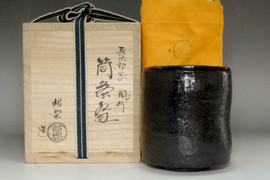Sasaki Shoraku (1944- ) Chojiro mukiguri style tea bowl #4059
- SKU:
- 4059
- Shipping:
- Free Shipping
- width: approx. 10.8cm (4 1⁄4in)
- height: approx. 8cm (3 5⁄32in)
- weight: 345g (gross 650g)
Sasaki Shoraku (1944- )
In 1905, the ancestor of the Nishikide school of pottery painting , Sasaki Kichinosuke, opened a kiln in Shimizuzaka, Kyoto. Under the guidance of the Zen Masters Goto Zuigan and Sesso Oda of the Daitoku-ji Temple, he used the great kiln of Daitoku-ji Temple to revive "Murasakino Pottery" (the kiln established in Daitoku-ji Temple in 1804 under the direction of the then-Head of Daitokuji-Temple, Chuho Souu (1759- 1838) , until its closing in 1818). His contributions to the reconstruction of Daitokuji after the war were recognized by Oda Sesso, and he received "Narumoken" order. The kiln was moved to Kameoka in Kyoto, as part of the 1944 evacuation. The name "Shoraku" was received from pottery work done by the founder of the Omoto religion, Deguchi Onisaburo, who knew about the kiln's moving. (“Yowan” tea bowls made of Shoraku kiln's clay by Onisaburo would later became famous.)
Sasaki Kichinosuke, the founder of the Shoraku kiln, was originally a painter of Nishiki-e style woodblock printing, and did not make tea bowls. It seems the kiln made flower pots until its second generation, with Sasaki Narimitsu (passed away in 1974). The third generation master, Sasaki Shoraku (real name Sasaki Teruo) has continued to make pottery specializing in tea utensils while studying Raku-yaki style pottery, and is also active using the Daitoku-ji kiln. Currently, Sasaki Koku (born 1964) is the fourth generation master of the Shoraku kiln.




















